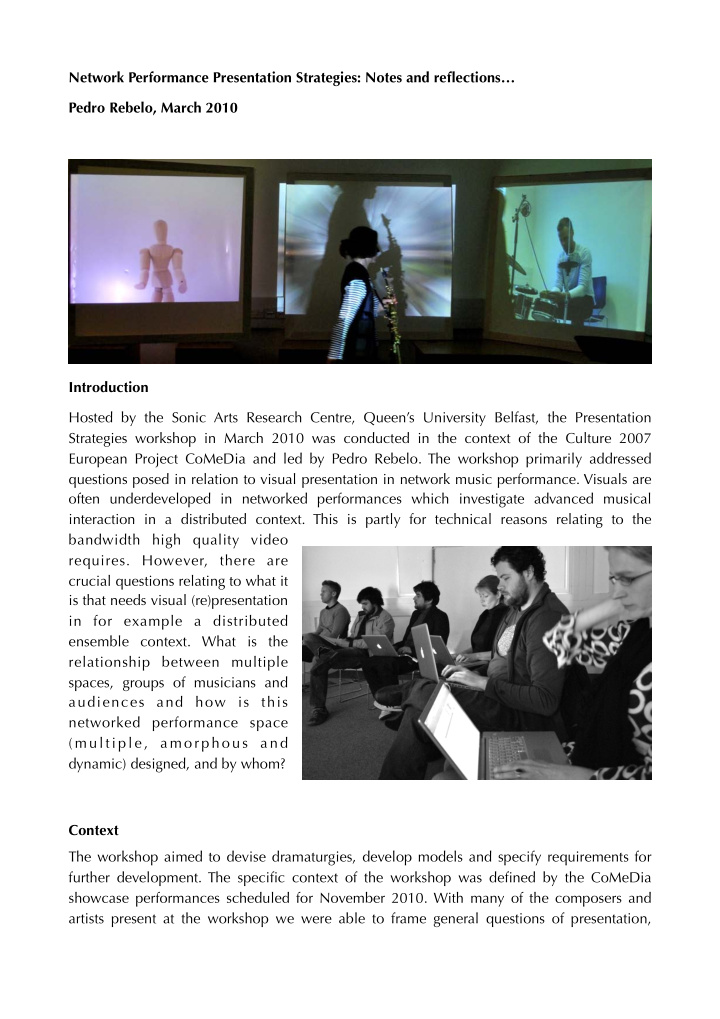



Network Performance Presentation Strategies: Notes and reflections… Pedro Rebelo, March 2010 Introduction Hosted by the Sonic Arts Research Centre, Queen’s University Belfast, the Presentation Strategies workshop in March 2010 was conducted in the context of the Culture 2007 European Project CoMeDia and led by Pedro Rebelo. The workshop primarily addressed questions posed in relation to visual presentation in network music performance. Visuals are often underdeveloped in networked performances which investigate advanced musical interaction in a distributed context. This is partly for technical reasons relating to the bandwidth high quality video requires. However, there are crucial questions relating to what it is that needs visual (re)presentation in for example a distributed ensemble context. What is the relationship between multiple spaces, groups of musicians and audiences and how is this networked performance space (m ultiple , a m or phous a nd dynamic) designed, and by whom? Context The workshop aimed to devise dramaturgies, develop models and specify requirements for further development. The specific context of the workshop was defined by the CoMeDia showcase performances scheduled for November 2010. With many of the composers and artists present at the workshop we were able to frame general questions of presentation,
display, scenography and dramaturgy in the context of specific pieces albeit at different stages of development. Day 1 Following a short introduction to the project and the aims of the workshop, all participants involved in the creation of a new work for the showcase briefly presented each piece from the perspective of the visual. These presentations were designed to highlight questions, points of interest and challenges across different artists/works and were not framed as a way of identifying requirements. A small group breakout session then dealt with further developing, synthesising and re-interpreting ideas coming out of the presentation with a view to developing a draft brief.
Day 2 The brief was then the starting point for the design of models addressing key general issues ( ra t h e r t h a n p i e c e - s p e c i fi c requirements). A number of these models were then implemented in a small scale to visualise spatial r e l a t i o n s h i p s , f r a m i n g , displacement using cameras, projectors and screens without the constrains of the network. In addition, participants gathered further information about each individual showcase piece, in relation to performers expected in each site. This exercise revealed that each piece is unlikely to have more than 3 musicians at each site.
- Space: Virtual vs Real/Physical relating to presence and absence. Containment - Direction/Instructions - Topologies (virtual - network) - Interactivity (access, influence/ c o m m u n i c a t i o n , a u d i e n c e ? ) . Anticipation/Reaction/Interaction - Scoring + Improvisation. Local - Global (shared, directed, dynamic?). Musical Language Challenges: - Consistency across pieces - Latency/Jitter - Spatial Representation (Metaphors: window, maps, portal, gates, tunnels, spotlights…)
Day 3 The third day dealt with testing some of the ideas in a more realistic scenario involving two performers and two notional sites. This session was useful in developing some of the ideas initially explored in the model and reflect on how they unfold at human scale and with the need for interaction and communication between two musicians. Design Proposal The workshop led to a concrete proposal for visual presentation design in multi-site networked performance. This proposal addresses the issues that were articulated during the workshop and thought to be important questions to address when thinking about video capture and projection in relation to traditional (pre-networked) staging strategies. The following issues were identified as crucial in relation to how cameras, projectors and screens are placed: - Scale (present and remote performers need to be at the same scale) - Orientation (performer’s and audience’s video must permit side glances, not frontal) - Position (extended frontal stage was adopted) - Eye Line (must be constant for all screens except generated video screen above) - Gaze (important not to overwhelm stage with large projection which competes with present musicians) - Framing (relating to spatial metaphors such as window, tunnel, spotlight…) Different sources for visual display were identified as: - Generated Video (graphics, scores, visualisations) - Performer’s Video (tight shots of performers/instruments) - Audience Video (context setting for each space)
The proposed model is based on clearly displaying the three types of visual materials while maintaining scale across local and remote performers and audiences. Purpose build screens are places close to local performers for the display of remote performers (framed so that eye line is constant). Image can be reframed between pieces so that all performers are in shot. Two further screens (identical to the ones used for performers) are placed to the side of the audience displaying remote audiences. Scale should be maintained b e t w e e n l o c a l a n d remote audiences. These screens act as a window onto each of the other performance spaces. A fifth screen (potentially of a different size) is placed above the local stage and above the “performer’s video” screens. This screen is intended for the local audience. When used for scores or instructions the image should be mirrored to monitors on stage facing the performers. The model will now be further developed through testing and implementation over the network. Acknowledgments Thank you to all participants (Felipe Hickman, Rob King, Rui Chaves, Pierre Prouske, Stephane Kyles, Franziska Schroeder, Steve Davis, Andrea Santini, Justin Yang, Patricia Alessandrini, Jacob Sello, Michael Gurevich, Donal O’Brian. Thank you also to Declan Keeney for a fantastic Final Cut Pro training session on day 4 and to Pearl Young and Marian Hanna for administrative support and Chris Corrigan and Una Monahan for technical support.
Recommend
More recommend